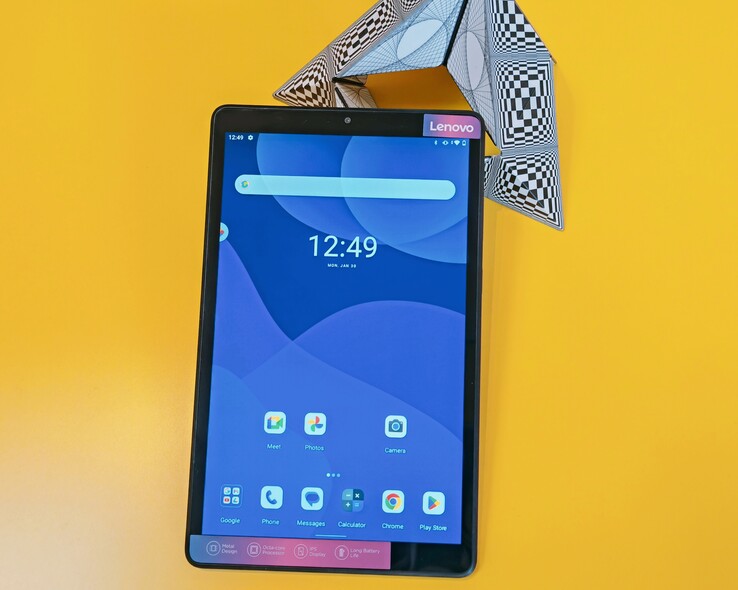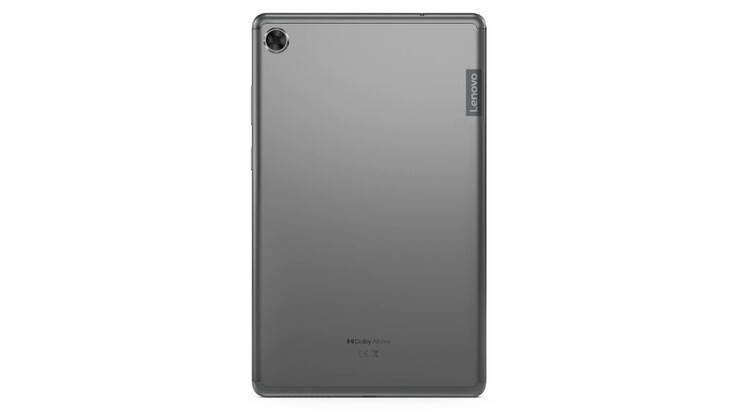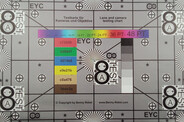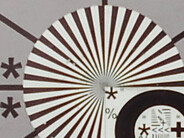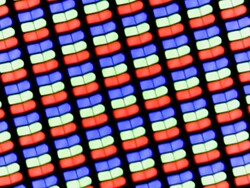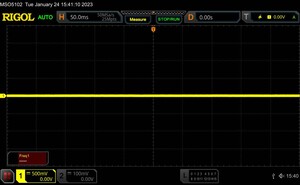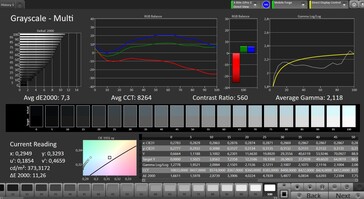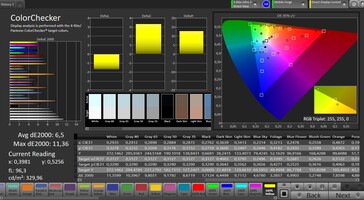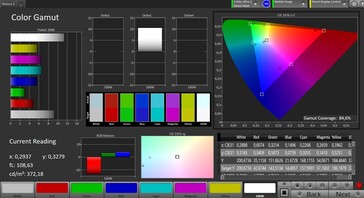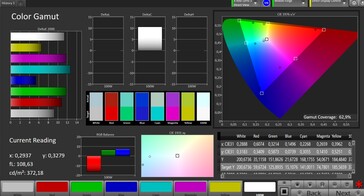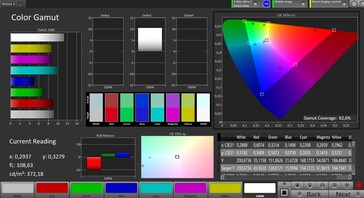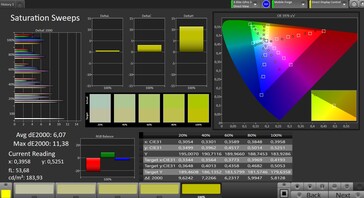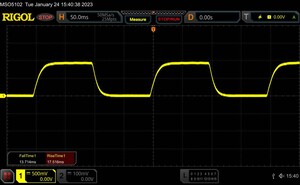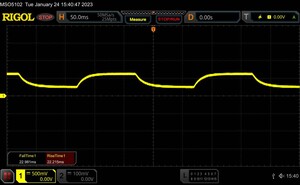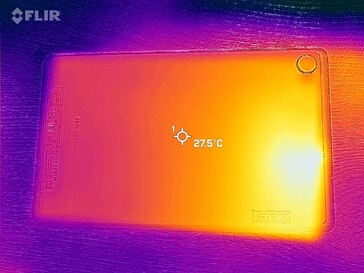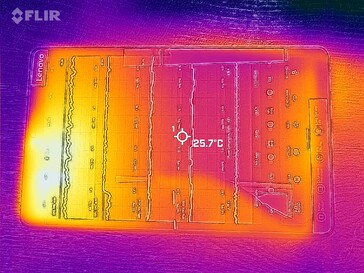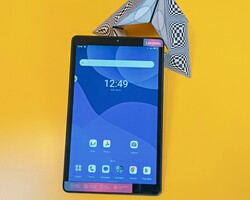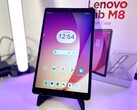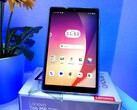Lenovo Tab M8 2022 (Gen 3) LTE review - Small tablet or huge smartphone?
Possible competitors in comparison
Rating | Date | Model | Weight | Height | Size | Resolution | Price |
|---|---|---|---|---|---|---|---|
| 80.8 % v7 (old) | 01 / 2023 | Lenovo Tab M8 (3rd Gen) Helio P22T MT8768T, PowerVR GE8320 | 305 g | 8.15 mm | 8.00" | 1280x800 | |
| 79.7 % v7 (old) | 08 / 2021 | Samsung Galaxy Tab A7 Lite Helio P22T MT8768T, PowerVR GE8320 | 366 g | 8 mm | 8.70" | 1340x800 | |
| 80.4 % v7 (old) | 01 / 2023 | Amazon Fire HD 8 2022 MT8169A, Mali-G52 MP2 | 337 g | 9.7 mm | 8.00" | 1280x800 | |
| 81 % v7 (old) | 01 / 2020 | Lenovo Tab M8 HD Helio A22 MT6762M, PowerVR GE8320 | 305 g | 8.2 mm | 8.00" | 1280x800 |
Case and features - Metal back on the Tab M8 2022
The Lenovo Tab M8 2022 is the third iteration of Lenovo's inexpensive and handy tablet, which is available for well under 200 Euros (~$200). Lenovo has released a Wi-Fi and an LTE variant. We test the variant that can also use the mobile network because it has an interesting feature: you can also make calls with the 8-inch tablet.
The casing has hardly changed visually compared to the 2nd generation, but it has become a bit narrower, which was achieved by even thinner edges around the screen. Furthermore, there is a quite stable metal back, the tablet can only be twisted a bit and then creaks quietly, but it looks very sturdy overall. It is very light with 305 grams.
Installed 32 GB of mass storage is tight, but at least you can also use microSD to store the data. However, the reader was a bit slow during the copying in our test with the reference microSD card Angelbird V60. Especially write speed is relatively slow.
| SD Card Reader - average JPG Copy Test (av. of 3 runs) | |
| Samsung Galaxy Tab A7 Lite (Toshiba Exceria Pro M501) | |
| Amazon Fire HD 8 2022 (Angelbird V60) | |
| Lenovo Tab M8 (3rd Gen) (Angelbird V60) | |
Cross Platform Disk Test (CPDT)
Communication, software and operation - Calls are supported
The Lenovo Tab M8 3rd Gen shows stable transfer rates in our Wi-Fi test. With the reference router Asus ROG Rapture AXE11000, we get speeds that are on a good level for a WiFi-5 device.
However, you can also insert a SIM card into the LTE version (our test device). If you want to use mobile Internet abroad, you should get detailed information before you leave, since many LTE frequencies are not supported.
The 8-inch tablet even offers a phone function. You can connect a headset or make calls directly via the tablet, but only via speaker and microphone (hands-free). We liked the call quality quite well in a short test call. The LTE tablet can also determine its position via satellite positioning.
Lenovo pre-installs Android 11, relies on a fairly pure system without major changes and does not install any third-party apps. The security patches are from November 2022 at the time of testing and thus need an update once again.
Operation via the 60-Hz touchscreen is mostly precise, but not always responsive since the system often jerks or needs a moment to process inputs. Even in the menu, the tablet is not always free from stutters, and operation becomes very sluggish in more complex apps.
There is no fingerprint sensor; you can only use face recognition as a biometric unlocking method. This works reasonably well in good light, but it takes a moment to recognize the face. Due to the software-based solution, this method is also not very secure against manipulation.
| Networking | |
| iperf3 transmit AX12 | |
| Samsung Galaxy Tab A7 Lite | |
| Lenovo Tab M8 HD | |
| iperf3 receive AX12 | |
| Samsung Galaxy Tab A7 Lite | |
| Lenovo Tab M8 HD | |
| iperf3 receive AXE11000 | |
| Amazon Fire HD 8 2022 | |
| Lenovo Tab M8 (3rd Gen) | |
| iperf3 transmit AXE11000 | |
| Amazon Fire HD 8 2022 | |
| Lenovo Tab M8 (3rd Gen) | |
Camera - Simple equipment
Due to the tight budget, the Tab M8 2022 also has to make do with very basic cameras: a 5-megapixel lens on the back serves as the main camera and takes poorly detailed photos with only low dynamics and sharpness. When the light gets dim and the contrasts increase, the picture gets even blurrier and there is usually nothing to see in dark areas.
The low sharpness of the camera is also evident in the lab picture, and the text is sometimes barely legible. The picture motifs completely disappear in 1 lux illumination.
Videos are possible in 1080p and 30 fps. However, the autofocus is slow and the overall picture quality is very mediocre.
On the front, there is an equally very basic 2-megapixel sensor as the camera. The selfies are usable for low demands but are often a bit dim and not very detailed.
Image comparison
Choose a scene and navigate within the first image. One click changes the position on touchscreens. One click on the zoomed-in image opens the original in a new window. The first image shows the scaled photograph of the test device.
Main cameraMain cameraLow Light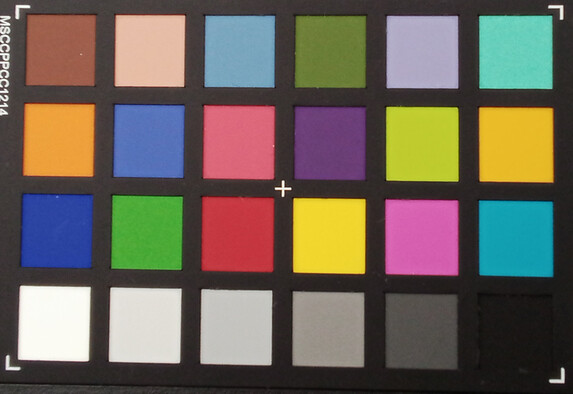
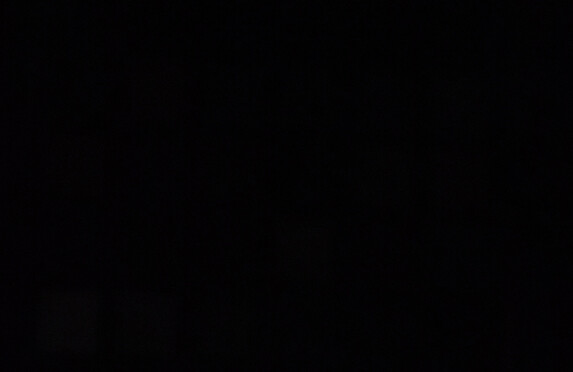
Display - Features typical for the class
You cannot expect a lot of brightness from relatively cheap tablet screens anyway. However, the IPS panel in the Tab M8 2022 is one of the rather dark screens with an average of 330 cd/m² even compared to other tablets. This makes outdoor use difficult, but it is usually sufficient for indoors.
The resolution of 1,280 x 800 pixels is standard for the class, but still results in somewhat blurry pictures. When streaming, you also have to live with the fact that the tablet does not have Widevine certification and thus content cannot be displayed in HD.
The contrast ratio also drops significantly due to the high black value, and the displayed colors look very dull. A color cast is visible in the grayscale. All brown tones are also clearly distorted.
At least we did not notice any PWM, so even people who are sensitive to flickering should be able to use the tablet well.
| |||||||||||||||||||||||||
Brightness Distribution: 81 %
Center on Battery: 353 cd/m²
Contrast: 552:1 (Black: 0.64 cd/m²)
ΔE ColorChecker Calman: 6.5 | ∀{0.5-29.43 Ø4.77}
ΔE Greyscale Calman: 7.3 | ∀{0.09-98 Ø5}
84.6% sRGB (Calman 2D)
Gamma: 2.118
CCT: 8264 K
| Lenovo Tab M8 (3rd Gen) IPS, 1280x800, 8" | Samsung Galaxy Tab A7 Lite TFT, 1340x800, 8.7" | Amazon Fire HD 8 2022 LCD, 1280x800, 8" | Lenovo Tab M8 HD IPS, 1280x800, 8" | |
|---|---|---|---|---|
| Screen | 28% | 34% | 53% | |
| Brightness middle (cd/m²) | 353 | 360 2% | 388 10% | 379 7% |
| Brightness (cd/m²) | 330 | 332 1% | 364 10% | 346 5% |
| Brightness Distribution (%) | 81 | 85 5% | 90 11% | 88 9% |
| Black Level * (cd/m²) | 0.64 | 0.24 62% | 0.36 44% | 0.21 67% |
| Contrast (:1) | 552 | 1500 172% | 1078 95% | 1805 227% |
| Colorchecker dE 2000 * | 6.5 | 6.7 -3% | 4.38 33% | 3.8 42% |
| Colorchecker dE 2000 max. * | 11.36 | 12.4 -9% | 10.7 6% | 7.5 34% |
| Greyscale dE 2000 * | 7.3 | 7.6 -4% | 2.9 60% | 5 32% |
| Gamma | 2.118 104% | 2.33 94% | 2.232 99% | 2.23 99% |
| CCT | 8264 79% | 8744 74% | 6221 104% | 7514 87% |
* ... smaller is better
Screen Flickering / PWM (Pulse-Width Modulation)
| Screen flickering / PWM not detected | |||
In comparison: 53 % of all tested devices do not use PWM to dim the display. If PWM was detected, an average of 8080 (minimum: 5 - maximum: 343500) Hz was measured. | |||
Display Response Times
| ↔ Response Time Black to White | ||
|---|---|---|
| 31.2 ms ... rise ↗ and fall ↘ combined | ↗ 13.7 ms rise | |
| ↘ 17.5 ms fall | ||
| The screen shows slow response rates in our tests and will be unsatisfactory for gamers. In comparison, all tested devices range from 0.1 (minimum) to 240 (maximum) ms. » 84 % of all devices are better. This means that the measured response time is worse than the average of all tested devices (20.2 ms). | ||
| ↔ Response Time 50% Grey to 80% Grey | ||
| 45.2 ms ... rise ↗ and fall ↘ combined | ↗ 23 ms rise | |
| ↘ 22.2 ms fall | ||
| The screen shows slow response rates in our tests and will be unsatisfactory for gamers. In comparison, all tested devices range from 0.165 (minimum) to 636 (maximum) ms. » 77 % of all devices are better. This means that the measured response time is worse than the average of all tested devices (31.6 ms). | ||
Performance, emissions and battery life - Little power, good runtimes
The MediaTek Helio P22T is an entry-level SoC that has a total of 8 cores with a clock rate of up to 2.3 GHz. It is also used in the Samsung Galaxy Tab A7 Lite but is already quite old at almost 5 years from its release. It is often sufficient for a reasonably smooth movement through the menus, but otherwise, the Lenovo Tab M8 2022 Gen 3 should rather be used for simple tasks. It often stutters in more demanding apps and operation becomes difficult.
The memory also proves to be very slow although the level is not high for very cheap tablets anyway.
The graphics card cannot do anything with the modern Wild Life benchmarks in 3DMark either. This casts a bad light on the tablet's future viability if you like gaming. Furthermore, the long-term stress test cannot be run either, so we have to switch to the GFXBench. Here, the tablet does not show any performance drops even after numerous runs of the benchmark. The heating under a longer load is hardly noticeable.
The speaker on the upper edge is alone, but it produces a good mono sound that does not overdrive even at maximum volume and lets you enjoy pop songs with balanced mids and trebles. Headphones or speakers can be connected via a jack socket or Bluetooth. Wireless codecs are aptX, aptX HD, SBC, AAC, and LDAC.
The battery is suitably sized with 5,000 mAh. The resulting runtimes in our WLAN test are also good at just over 16 hours and are sufficient for a day without a power outlet. You have to be a bit patient when charging: when the battery is low, it can take up to 3 hours or even longer until 100% is displayed again.
| Lenovo Tab M8 (3rd Gen) | Samsung Galaxy Tab A7 Lite | Amazon Fire HD 8 2022 | Lenovo Tab M8 HD | Average 32 GB eMMC Flash | Average of class Tablet | |
|---|---|---|---|---|---|---|
| AndroBench 3-5 | 88% | 38% | 36% | 38% | 1460% | |
| Sequential Read 256KB (MB/s) | 262.1 | 271.1 3% | 270.37 3% | 297.1 13% | 242 ? -8% | 1864 ? 611% |
| Sequential Write 256KB (MB/s) | 66.7 | 87.2 31% | 113.44 70% | 79.6 19% | 100.5 ? 51% | 1406 ? 2008% |
| Random Read 4KB (MB/s) | 50.8 | 60.8 20% | 39.46 -22% | 77.4 52% | 43.1 ? -15% | 254 ? 400% |
| Random Write 4KB (MB/s) | 9.9 | 39.51 299% | 19.81 100% | 15.84 60% | 22.3 ? 125% | 289 ? 2819% |
(+) The maximum temperature on the upper side is 30.9 °C / 88 F, compared to the average of 33.6 °C / 92 F, ranging from 20.7 to 53.2 °C for the class Tablet.
(+) The bottom heats up to a maximum of 31.3 °C / 88 F, compared to the average of 33.2 °C / 92 F
(+) In idle usage, the average temperature for the upper side is 25.4 °C / 78 F, compared to the device average of 30 °C / 86 F.
Lenovo Tab M8 (3rd Gen) audio analysis
(±) | speaker loudness is average but good (77.1 dB)
Bass 100 - 315 Hz
(-) | nearly no bass - on average 23.7% lower than median
(±) | linearity of bass is average (8% delta to prev. frequency)
Mids 400 - 2000 Hz
(+) | balanced mids - only 4.6% away from median
(±) | linearity of mids is average (9% delta to prev. frequency)
Highs 2 - 16 kHz
(±) | higher highs - on average 6.5% higher than median
(+) | highs are linear (5.7% delta to prev. frequency)
Overall 100 - 16.000 Hz
(±) | linearity of overall sound is average (23.9% difference to median)
Compared to same class
» 74% of all tested devices in this class were better, 6% similar, 20% worse
» The best had a delta of 7%, average was 20%, worst was 129%
Compared to all devices tested
» 71% of all tested devices were better, 7% similar, 22% worse
» The best had a delta of 4%, average was 24%, worst was 134%
Lenovo Tab M8 HD audio analysis
(+) | speakers can play relatively loud (86 dB)
Bass 100 - 315 Hz
(-) | nearly no bass - on average 24.5% lower than median
(±) | linearity of bass is average (8.7% delta to prev. frequency)
Mids 400 - 2000 Hz
(±) | higher mids - on average 6.9% higher than median
(+) | mids are linear (6.1% delta to prev. frequency)
Highs 2 - 16 kHz
(±) | higher highs - on average 12.3% higher than median
(+) | highs are linear (3.3% delta to prev. frequency)
Overall 100 - 16.000 Hz
(±) | linearity of overall sound is average (27.7% difference to median)
Compared to same class
» 86% of all tested devices in this class were better, 3% similar, 11% worse
» The best had a delta of 7%, average was 20%, worst was 129%
Compared to all devices tested
» 84% of all tested devices were better, 3% similar, 13% worse
» The best had a delta of 4%, average was 24%, worst was 134%
| Lenovo Tab M8 (3rd Gen) 5000 mAh | Samsung Galaxy Tab A7 Lite 5100 mAh | Amazon Fire HD 8 2022 4850 mAh | Lenovo Tab M8 HD 5100 mAh | |
|---|---|---|---|---|
| Battery runtime | -16% | -2% | 17% | |
| WiFi v1.3 (h) | 16 | 13.4 -16% | 15.6 -2% | 18.7 17% |
| Reader / Idle (h) | 41.1 | 59.7 | ||
| H.264 (h) | 13.3 | 28.3 | ||
| Load (h) | 4.1 | 6.2 |
Pros
Cons
Verdict - A special tablet with LTE
The Lenovo Tab M8 2022 is a cheap and handy tablet that has interesting application possibilities due to its LTE version and the possibility to make phone calls. Thus, you can also use the tablet outside of the WLAN and make calls on the go without a separate smartphone.
However, a few things have to be considered: the screen is quite dark and low-contrast, so you can only read it reasonably outdoors in shady environments. At least we did not notice any PWM flickering. Phone calls can only be made via the built-in speakerphone unless a headset is connected, so everyone can listen in.
The cameras are, as with most inexpensive tablets, only useful for snapshots or scanning QR codes. The speaker is not too bad, and the Wi-Fi and LTE connections are stable and fast. Thanks to the GNSS module, the tablet can also be used for navigation.
However, the processor is quite slow, and the scarce and sluggish memory is no real joy. You also have to be content with infrequent patches in terms of software updates.
As an LTE version, the inexpensive Lenovo Tab M8 2022 (Gen 3) offers interesting features, but slow components slow it down.
The Samsung Galaxy Tab A7 Lite is also available as an LTE version, but you cannot make calls with it. Amazon's Fire HD 8 is even cheaper, but you have to live with limited software.
Price and availability
The Tab M8 2022 LTE is not available at Lenovo at the time of testing. At amazon.de you can buy it for 177 Euros.
The Wi-Fi version is currently hardly cheaper at retailers on the Internet.
Lenovo Tab M8 (3rd Gen)
- 01/30/2023 v7 (old)
Florian Schmitt
Transparency
The selection of devices to be reviewed is made by our editorial team. The test sample was provided to the author as a loan by the manufacturer or retailer for the purpose of this review. The lender had no influence on this review, nor did the manufacturer receive a copy of this review before publication. There was no obligation to publish this review. As an independent media company, Notebookcheck is not subjected to the authority of manufacturers, retailers or publishers.
This is how Notebookcheck is testing
Every year, Notebookcheck independently reviews hundreds of laptops and smartphones using standardized procedures to ensure that all results are comparable. We have continuously developed our test methods for around 20 years and set industry standards in the process. In our test labs, high-quality measuring equipment is utilized by experienced technicians and editors. These tests involve a multi-stage validation process. Our complex rating system is based on hundreds of well-founded measurements and benchmarks, which maintains objectivity. Further information on our test methods can be found here.


